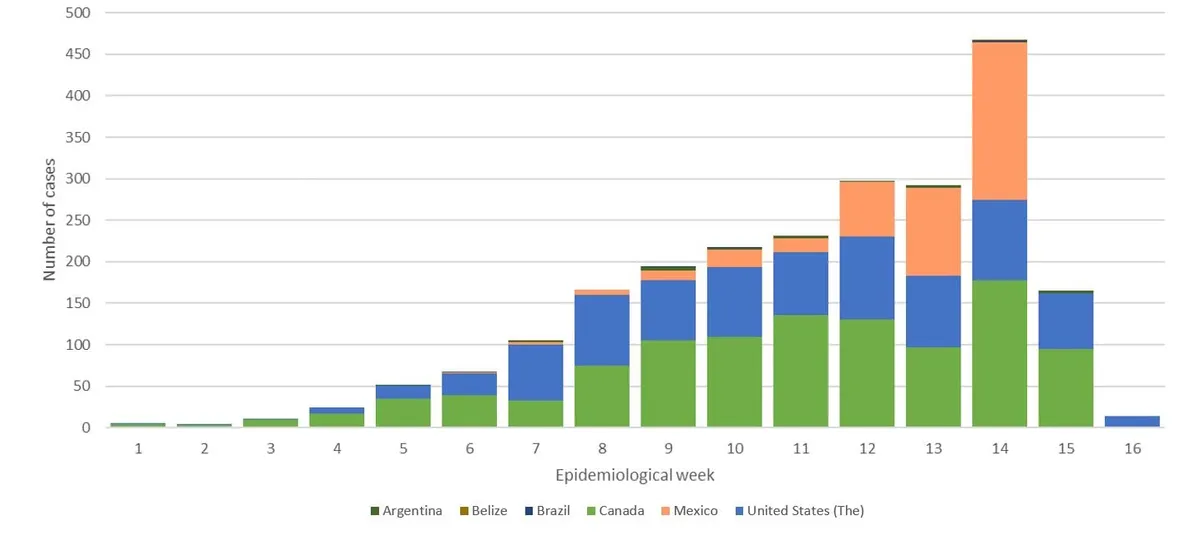
From 1 January to 18 April 2025, the WHO Region of the Americas has reported a staggering total of 2,318 confirmed measles cases, including three fatalities. This marks an alarming 11-fold increase compared to the 205 cases documented during the same timeframe in 2024. The outbreak spans six countries: Argentina, Belize, Brazil, Canada, Mexico, and the United States of America, reflecting widespread challenges in measles vaccination.
The distribution of measles cases reveals significant disparities across regions. In Canada alone, 1,069 cases have been confirmed, predominantly linked to a large outbreak among unvaccinated individuals. Comparatively, Mexico reported 421 cases, while the United States recorded 800 cases, including two deaths. The details of each country’s outbreak provide critical insights into the factors contributing to the rise in measles cases.
Between 1 January and 16 April 2025, Argentina reported 21 confirmed measles cases, primarily in the Autonomous City of Buenos Aires and Buenos Aires Province. The index case was identified on 31 January 2025, in a child who had traveled internationally. Notably, three cases were imported, and 13 were linked to these initial infections. The majority of cases were among individuals aged between 5 months and 40 years, with minimal hospitalization required.
In a worrying development, the Belize Ministry of Health & Wellness confirmed two positive cases of measles on 12 April 2025, the first since 1991. Both cases involved unvaccinated 17-year-old males who had traveled to Chihuahua, Mexico, for a religious gathering. Despite efforts to increase vaccination rates, Belize’s coverage remains below the target of 92-95%.
Brazil documented five confirmed measles cases from 1 January to 18 April 2025, with infections occurring in multiple locations. Most notably, two cases involved unvaccinated children under one year old, while adults with a history of international travel accounted for the remaining cases. The continuous spread of measles indicates ongoing challenges in maintaining high vaccination coverage.
Canada has seen a dramatic rise in cases, with 1,069 confirmed and probable cases reported from seven provinces by 12 April 2025. This surge represents the highest annual case count since the country achieved measles elimination in 1998. The outbreak is primarily linked to unvaccinated individuals in under-vaccinated communities, emphasizing the urgent need for improved vaccination campaigns.
From 1 January to 16 April 2025, Mexico confirmed 421 measles cases, including one death. The majority of cases were linked to unvaccinated individuals, highlighting significant gaps in vaccination coverage. The first confirmed case emerged from an unvaccinated child with a history of international travel, underscoring the link between travel and measles resurgence.
As of 17 April 2025, the United States reported 800 confirmed measles cases across 25 jurisdictions, with the majority associated with outbreaks. Notably, children under five accounted for a significant portion of cases, emphasizing the vulnerability of younger populations. The decline in MMR vaccination coverage in recent years poses a serious public health concern.
The overall risk of measles in the Americas is classified as high, driven by several factors including ongoing virus circulation from imported cases and suboptimal vaccination coverage. In 2023, only 28.6% of countries in the region achieved over 95% coverage for the first MMR dose, with 16.7% for the second dose. The challenges posed by the COVID-19 pandemic and vaccine hesitancy exacerbate the situation, creating pockets of unvaccinated individuals.
The global risk of measles transmission remains moderate but concerning, particularly in regions with low vaccination coverage. Continued efforts to improve measles vaccination rates, enhance surveillance, and respond to outbreaks are crucial to mitigating the threat posed by this highly contagious disease.